 Another two months of magnetic implants |
“Man could escape danger only by renouncing adventure, by abandoning that which has given to the human condition its unique character and genius among the rest of living things.”
Most years I publish an “April Fools” article here on BME (articles like Adding and Subtracting, Joshua, The Raelians, and Love at First Bite). This year I’d like to write about dealing with the aftermath of something arguably foolish instead. As you know, last year I had magnets implanted in my fingertips in order to allow me to sense electromagnetic fields. While I’ve been very happy with them on the sensation end of things, as I left off with the last article, it appeared that one of the magnets had started to break down after its silicone coating was damaged by opening a pickle jar wrong (please read that original article first if you have not already).

Since that writing, as you can see above, the other side of my hand got similarly irritated (although no trauma that I know of occurred to initiate it as it had on the first problem) and started to blacken and become uncomfortable. I also started seeing photos of magnets taken from other people’s bodies which had significantly broken down — here is, I believe, what is happening:

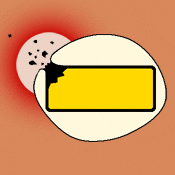

The magnet starts as a small gold-coated neodymium (rare earth) magnet encased in a thin bubble of silicone. These magnets are tiny (about a third the size of a grain of rice), so the coating is extremely fragile in parts. It doesn’t take much for it to become compromised, and with only a tiny gap (as seen in the middle picture), the body starts to break down the magnet, extracting the substances it can use and trying to encapsulate those that are toxic. Not long after (within weeks if not less), the magnet is almost completely broken down and becomes a loose powder of toxic elements surrounded by bits of silicone. At this point it has of course also lost its magnetism so it is no longer functional either.
Because the effects of neodymium exposure of this type are relatively unknown, and in other circumstances the substance is known to be cytotoxic, mutagenic, and carcinogenic, and because it was somewhat painful, I believe it made sense to have them removed. I asked my friend Tom Brazda to do the extraction — he’s the only person I’d trust to do this (and I suspect there are few piercers who know him and his work that wouldn’t put him on a top five body piercers of all time list).
On to the gory details. Be warned that these pictures are graphic.
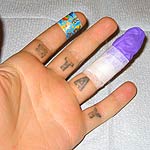
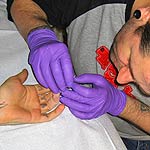
In the first picture we’re applying a topical anesthetic to my finger. The glove-cot contraption is on because the anesthetic needs to be applied without coming in contact with the air. In the second shot Tom is doing a final check of my finger and marking the location of the implants. While four implants had been originally installed, only two appeared to be there eight months later.
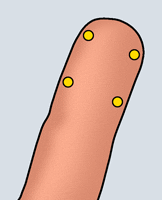

My suspicion is that the set slowly migrated together. I believe this shifting has caused them to appear as two, and I also believe that it’s possible that this shifting, which would have caused the two units to vibrate against each other, may have accelerated the breakdown of the silicone.
Oh, and at about this point I got a phone call from a friend urging us to consider aborting the removal… She’d had her doctor (a GP) remove hers, and he cut down toward it, reached in to grab it, and it just fell to pieces… He backed out and referred her to a plastic surgeon. So far she has kept it, and three months later her finger is very discolored (far more than mine was), and still quite sore. She did however mention that she found a clinical reference to neodymium — it is at times used in laboratory mice to extend their lifespans. Hmm… Maybe it’s not so toxic after all?
Naw, better safe than sorry I think!
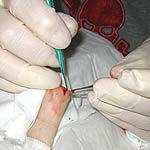
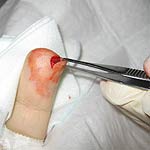
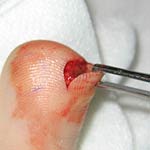
Anyway, we began cutting a flap over the more recent and more irritated of the two magnets. Rather than just cutting down and spreading the skin and trying to pull it out, the plan was to make a cut that would let us just fold open the skin over the implant and remove it either by excision, scraping it off, or irrigating it out depending on the consistency. We couldn’t be sure what the specifics of the procedure would be until we actually got in there.
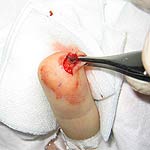
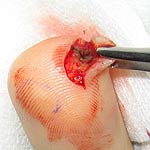
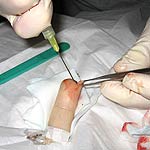
The top half of one or two of the magnets pretty much just fell out (you can see one in the first picture), but we were left with a largely empty cyst-like shell made up of and surrounded by blackened tissue. There were some loose flakes and powder but most seemed to be a part of the spongy mass of scar tissue. Irrigating it didn’t move anything, and it was completely adhered to the flesh around it, so there was no way to grab it and pull it out. All we could do is cut all around it and remove it as a single piece.
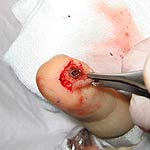
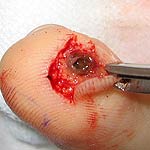
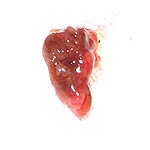
Some healthy tissue was removed, but the majority (if not all) of the toxic material from that side appears to be gone.
Going into the second side (the older of the two compromised sides) we encountered a little different tissue. The implant also sat quite a bit deeper in the flesh; deep enough that we couldn’t be completely sure at the time there wasn’t another hidden behind it (and while I think it’s gone, I won’t be entirely certain what’s left until the healing is done).
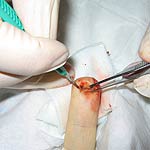
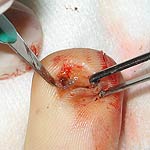


When we’d dug down deep enough to expose it, the good news was that the cyst was quite well developed. It was rooted in place a little, but we were able to pull it out without significant damage to the surrounding fingertip and with minimal excision of healthy flesh. It was seriously gross though seeing these really vile and rotten looking blobs coming out of my finger!


Now, with my fingertip completely exposed, but finally clean, it was time to stitch me back together, and we were done. I’ve been very stressed out over these problems, and it felt so good to see those sutures going in and knowing this was almost over.

My only regret is that we accidentally threw away the removed tissue and magnet bits as we were disinfecting the workspace. I’d hoped to take a much closer look at the magnet, but unfortunately that “oops” moment killed that. I can however share with you a magnet that rejected from the finger of a friend of Steve Truitt after about four months. This one has barely broken down, but the silicone is gone from one side, part of the gold coating has eroded, and the inner core has started to decompose.
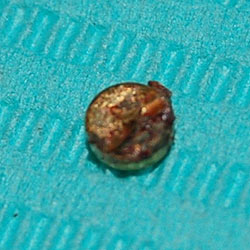
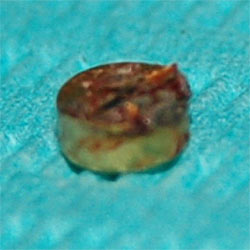
Some people’s bodies will reject the magnets like a splinter (the lucky people), other bodies will try and encapsulate them, others will try and break them down, or a combination of all of these strategies. Internal body chemistry will also greatly affect how quickly the process happens.
I’m treating the wound with Neem pills and a Neem spray and so far it appears to be healing quite well. My right hand, which also contains magnets (but in a stacked configuration and with a thicker coating of silicone), so far has experienced no problems. In fact, it’s gotten more sensitive over time and I find myself becoming more and more aware of the electromagnetic environment around me (for example, noticing “hot spots” in power cables and couplings that are leaking radiation into the air)… But, I think it’s only a matter of time before that stack is compromised as well, and as sad as it will be to remove them, I think I have to take them out as well.
Talking to Steve Haworth and others, it sounds like a significant percentage of the small magnets implanted in people are already breaking down. It’s effectively a defective product, not even safe enough for a year in the body, let alone a lifetime. Steve tells me he’s considering ceasing sales of his smallest units (they are currently for sale on eBay), but honestly, especially given that we’ve known now for months that they’re not very stable, I feel that it needs to go a step farther and a recall needs to be issued for all of the silicone coated magnets that are out there. I do not believe that any of them will remain stable in the long term, and I believe that all of them will break down in time as I’ve described here.
One of the problems with body modification these days is, well, BME and the internet in general… When someone comes up with a great new idea like these magnetic implants (and it is a great idea), it’s instantly posted, and everyone wants it right now. But now, because of that rush, there are dozens of people, many not inside the body modification industry (so they’re without easy access to removal, let alone monitoring), that need surgery that could have been averted with a proper testing cycle.
I’d like to propose that for volatile implants and other procedures that can have unforeseen effects on the body, that these procedures should be limited to people working inside a studio or otherwise able to go to the studio the practitioner works in on a nearly daily basis. These things need to be aggressively monitored and documented so the risks are thoroughly known before they move into the client sphere. It’s one thing when we endanger ourselves as professionals inside this industry, but it’s another thing if clients who may not understand that the risks are not fully known are put into that same danger.
When I receive photos to BME, for every thousand fresh photos I receive perhaps one hundred healed photos… Of the two, it’s the healed photo that has more value. Think surface piercings — you can do a crazy corset with rings and it looks great fresh, or a forearm piercing with a straight bar and it looks great fresh too, but good luck getting a healed photo. Furthermore, for every healed photo I get, I get one problem photo (that is, a photo of a serious complication). I think because when people get a body modification others tell them it’s a stupid thing to do and too dangerous, so when things go wrong, there’s often a sense of shame and embarrassment… So they hide that the problem happened, and other people repeat their mistakes because they were unaware of the risk.
Let me be very clear about this: things go wrong all the time. It’s part of the game. But when things do go wrong, rather than hiding it, we need to share everything we know about the problems so they are less likely to happen to someone else.
In this magnetic implant procedure, one main simple thing went wrong: the magnet is not stable in the body, and the coating provided was not a sufficient permanent barrier between the magnet and the body. For existing people, I again strongly urge removal — and don’t kid yourself into thinking that because yours hasn’t broken down yet that you should be able to keep it. If yours hasn’t broken yet, thank your lucky stars that removal is going to be much simpler!
For people who’ve not gotten magnets implanted, I really have to emphasize that implanting this style of magnet with a thin silicone sheath, knowing what we now know, is reckless to the point of being stupid, since it simply doesn’t work. The initial product has turned out to be defective — but I believe we can still make this work. Glass (like an RFID) won’t work because the magnet can’t be exposed to heat without de-magnetizing it. There are however other polymers such as polyurethane (used to coat artificial hearts) with better durability and good biocompatibility that can be applied and cured at room temperature. So don’t think the idea of giving humans magnetic vision is a dead one!
[Please be sure to visit the companion article to this by Jesse Jarrell; it’s a great explanation as to the thinking that went into the development, and also includes some of Jesse’s ideas as to why things have gone wrong and how they could be fixed.]
But let’s be sure that we take it slow, wait out a few people testing them before we go putting hundreds of experimental devices into people who can’t easily find removal options, and document our failures as well as our brilliant theories! There’s nothing wrong with taking risks, but taking needless ones is, well, foolish.

 BME/News and Modblog highlight only a small fraction of what
BME/News and Modblog highlight only a small fraction of what
I first read about this some time ago and was immediately interested in getting one. I believe that there are two problems with this procedure.
1. The breakdown of the silicon and
2. The location of the implant. Having it on your finger tips makes it easier to “see magnetically” but does expose you to a certain risk. Perhaps a left hand or forearm implant would have been more successful?
As for the coating, glass coatings have been used for some time with much success. Pets have been implanted with RFID chips, about the size of a grain of rice, and coated with a porous glass coating that allows proteins to bind to the implant to prevent it from moving. I found this quote on the topic:
“Another common form factor is surgically implantable tags encased in a special biologically inert glass called “soda glass” and shaped to be approximately the size of a large grain of rice. Implantable tags are often coated with a special sleeve that is slightly porous to allow protein strands to grow into it and prevent it migrating under the skin after implantation. They are commonly used to tag domestic animals such as cats and dogs so they can be identified by a vet or pet shelter using a special RFID reader if they are lost. Some people, including one of the authors of this book, have even implanted RFID tags in themselves so they can operate access control systems without having to carry anything!”
From: “Practical Arduino: Cool Projects for Open Source Hardware”
by Jonathan Oxer and Hugh Blemings
If you do continue to carry on this area of experimentation please let me know as I am very interested in following this story. If you’d like any further information on the subject, please feel free to contact me at the email address I provided in this comment box.
Regards,
Sean